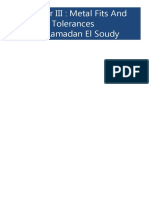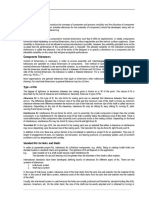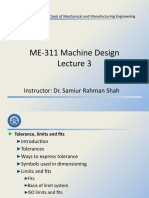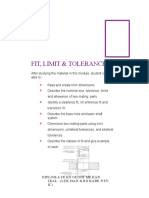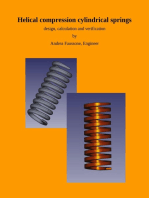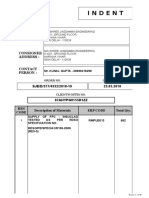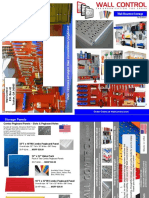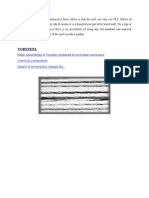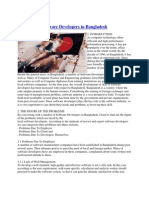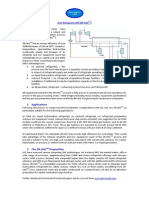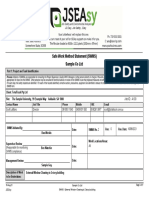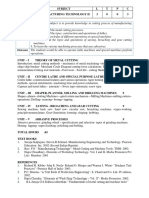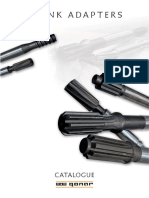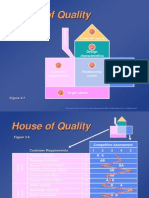sizing-and-dimensioning_with-examples (1)
Uploaded by
godwill naldsizing-and-dimensioning_with-examples (1)
Uploaded by
godwill naldCHAPTER III
SIZING AND DIMENSIONING
Objectives:
At the end of this chapter, the students should be able to: identify the differences between
tolerance, allowance and fits; know the different types of fits and their classification; and solve
problems specifying allowance, and tolerances. Understand the basic principles of fits and
tolerances. Know the fundamental of the systems of fits
INTRODUCTION
A machine element, after design, requires to be manufactured to give it a shape of a
product. Therefore, in addition to standard design practices like, selection of proper material,
ensuring proper strength and dimension to guard against failure, a designer should have
knowledge of basic manufacturing aspects.
First and foremost is assigning proper size to a machine element from manufacturing
view point. As for example, a shaft may be designed to diameter of, say, 40 mm. This means, the
nominal diameter of the shaft is 40 mm, but the actual size will be slightly different, because it is
impossible to manufacture a shaft of exactly 40 mm diameter, no matter what machine is used. In
case the machine element is a mating part with another one, then dimensions of both the parts
become important, because they dictate the nature of assembly. The allowable variation in size
for the mating parts is called limits and the nature of assembly due to such variation in size is
known as fits.
SIZE DESIGNATIONS
1. Nominal Size /trade size - It is the designation used for general identification and is
usually expressed in common fractions. Not necessarily its actual size when finished. For
example for a screw thread, nominal size of 1/4” , 20 threads per inch UNC.
2. Basic Size or Basic Dimension - It is the theoretical size from which limits of size are
derived by the application of allowances and tolerances. , and so on
3. Actual Size - is the measured size of the finished part.
4. Allowance - is the minimum clearance space (or maximum interference)intended
between the maximum material condition of mating parts.
Tolerance – permissible variation of the size of a dimension. It is the difference between the
maximum (upper) and the minimum(lower) limits for the dimension. In mechanical engineering,
the space between the bolt and a nut on a hole.
Tolerance maybe:
a. Bilateral – the size of a part is permitted to be either larger or smaller than the given
dimension. In this system, the dimension of the part is allowed to vary on both sides
of the basic size, i.e. the limits of the tolerance lie on either side of the basic size, but
may not be necessary equally dispose about it.
tolerance
tolerance
Basic size
Figure: Bilateral tolerance
b. Unilateral – the size of a part maybe larger only, or smaller only, than the given
dimension. Usually used in signifying fits for interchangeable parts.
In this system, the dimension of a part is allowed to vary only on one side of the basic
size,i.e. tolerance lies wholly on one side of the basic size either above or below it.
tolerance
tolerance
basic size
Figure: Unilateral tolerance
BILATERAL UNILATERAL
+ 0.0025
¾± 2.875
- 0.0000
+ 0.0000
3.125± 0.0625 1.575
-0.010
Example: 1. A shaft of 25mm basic size is given 25 . Find the tolerance.
Solution:
Maximum permissible size(upper) = 25.02
Permissible size (lower limit) = 24.98 Therefore: tolerance = 25.02 – 24.98 = 0.04mm
1. A 50mm diameter shaft is made to rotate in the bush. The tolerances for both shaft and
bush are 0.050mm. Determine the dimension of the shaft and bush to give a maximum
clearance of 0.075mm with the hole basis system.
Solution:
In the hole basis system, lower deviation of hole is zero, therefore low limit of hole =
50mm.
High limit of hole = low limit + tolerance
= 50.00 + 0.050
= 50.050mm
High limit of shaft = low limit of hole – allowance
= 50.00-0.075
= 49.925mm
Low limit of the shaft = high limit – tolerance
= 49.925-0.050
= 49.875mm
Fit – general term refers to the relative looseness (clearance fit) or tightness (interference fit) of
mating parts, especially as it affects the motion of the parts or the force between them after
assembly.
. It is the dimensional relationship between mating parts like press shrink or sliding fit.
Three (3) Types of Fit:
1. Clearance fit – is one having limits of size so prescribed that a clearance always
results when mating parts are assembled. An internal member fits in an external
member (as a shaft in a hole) and always leaves a space or clearance between the
parts.
- The difference between the sizes of the hole and the shaft, before assembly, when this
difference is .
- Usually referred to as “sliding fit”.
Sub-classified as follows:
a. Loose- fit – It is used between those mating parts where no precision is required.
It provides minimum allowance and is used on loose pulleys, agricultural
machineries.
b. Running fit – The dimension of the shaft should be smaller enough to maintain a
film of oil for lubrication. It is used in bearing pair. An allowance of 0.025 mm
per 25mm of diameter of boaring may be used.
c. Slide-fit or medium fit – It is used in those mating parts where great precision is
required. It provides medium allowance and is used in tool slides, slide valves,
automobile parts.
Example. A spindle slides freely in a bush. The basic size of the fit is 50 x10-3mm. If the
+62 -80
tolerances quoted are for the holes and for the shaft, find the upper limit and lower limit
0 -180
Of the shaft and the minimum clearance.
Solution. Tolerances are given in units of one thousandth of millimeter, so the upper limit of the
hole will be 50.062 mm and the lower limit for the hole is the same as the basic size of
50.000mm.
The shaft upper limit will be (50.000 -0.080)x10-3 = 49.92x10-3 mm
The shaft lower limit will be (50.000 -0.180)x10-3 = 49.82x10-3 mm
The minimum clearance or allowance is (50.000 – 49.82)x10-3 = 8x10-3 mm
2. Interference fit - is one having limits of size so prescribed that an interference always
results when mating parts are assembled. “ When a pin is larger than the hole, the
allowance is as before the difference in sizes for the tightest fit, a difference is called
interference of metal or negative allowance”.
- The difference between the sizes of the hole and the shaft before assembly, when the
difference is negative.
Sub-classified as follows:
a. Shrink fit or heavy force fit – It is used in fitting of rims. It refers to maximum negative
allowance
b. Medium force fit – used in car wheels, armature of dynamos. It refers to medium negative
allowance
c. Tight fit or press fit - used on a keyed pulley and shaft, rocker arm. One part can be assembled
into t he other with a hand hammer or by light pressure
3. Transition fit - is one having limits of size so prescribed that either a clearance or an
interference may result when mating parts are assembled.
- It is between clearance and interferences, where the tolerance zones of the holes and
shaft overlap.
Sub-classified as follows:
a. Snug fit/push fit – refers to a zero allowances and a light pressure is required in
assembling the hole and the shaft.
b. Force fit/shrink fit – used when the two mating parts are to be rigidly fixed so that one
cannot move without the other.. It either requires high pressure to force the shaft in to the
holes by heating.
c. Wringing fit – a slight negative allowance exists between two mating parts in wringing fit. It
requires pressure to force the shaft into the hole and gives a light assembly. It is used in fixing
keys, pins.
Classification of Fit:
RC 1 : Close sliding fit
RC 2 : Sliding fit
RC 3 : Precision-running fits
RC 4 : Close-running fits
RC 5 & 6 : Medium running fits
RC 7 : Free-running
RC 8 & 9 : Loose-running
Classes of Interference Fits: five classes of force fits are defined in ANSI Standard
FN 1 : For light drive fits
FN 2 : For medium drive fits
FN 3 : For heavy drive fits, heavy steel
FN 4 : Force fit
: Used for high-strength assemblies where high resulting pressures
are required.
FN5 : (force fit)
: Similar to FN4 for higher pressures.
Running Fit – is the minimum specified difference between the dimensions of the pin (male
part) and the hole (female part).
Illustrative Example: A shaft with a nominal diameter of 8” is to fit in a hole. Specify the
allowance, tolerances, and the limit diameter of the shaft and hole on a sketch for:
a. Close-sliding fit
b. Precision- running
c. Medium-running
d. Close-running
Given:
Nominal diameter = 8”
Solution:
a. Close-sliding fit (RC 1)
From Table 3.1 pg 83, Design of Machine Elements 4 th Edition by Virgil Moring
Faires
HOLE SHAFT
+ 0.8 - 0.6
0 - 1.2
Shaft Tolerance = -0.6 – (-1.2)
= 0.6 x 10-3
Hole Tolerance = 0.8 x 10-3
Allowance = 0.0006
Max Shaft Diameter = 8 + (0.6 x 10-3 )
= 7.9994
Min Shaft Diameter = 8 – (1.2 x 10-3 ) = 7.9988
Max Hole Diameter = 8 + (0.8 x 10-3 ) = 8.008
Min Hole Diameter = 8.000
b. Precision-running fit (RC 3)
From Table 3.1 pg 83, Design of Machine Elements 4 th Edition by Virgil Moring
Faires
HOLE SHAFT
+ 1.2 - 2.0
0 – 3.2
Shaft Tolerance = -2 – (-3.2)
= 1.2 x 10-3
Hole Tolerance = 0.0012
Allowance = 0.002
Max Shaft Diameter = 8 + (-2.0 x 10-3 )
= 7.998
Min Shaft Diameter = 8 – (3.2 x 10-3 )
= 7.9968
Max Hole Diameter = 8 + (1.2 x 10-3 )
= 8.0012
Min Hole Diameter = 8.000
c. Medium-running fit (RC 5 & 6)
RC 5:
From Table 3.1 pg 83, Design of Machine Elements 4th Edition by Virgil Moring Faires
HOLE SHAFT
+ 1.8 - 4.0
0 – 5.8
Shaft Tolerance = -4 – (-5.8)
= 1.8
Hole Tolerance = 0.0018
Allowance = 0.004
Max Shaft Diameter = 8 + (-4.0 x 10-3)
= 7.996
Min Shaft Diameter = 8 – (5.8 x 10-3 )
= 7.9942
Max Hole Diameter = 8 + (1.8x 10-3 )
= 8.0018
Min Hole Diameter = 8.000
RC 6:
From Table 3.1 pg 83, Design of Machine Elements 4 th Edition by Virgil Moring
Faires
HOLE SHAFT
+ 2.8 - 4.0
0 – 6.8
Shaft Tolerance = -4 – (-6.8)
= 2.8
Hole Tolerance = 0.0028
Allowance = 0.004
Max Shaft Diameter = 8 + (-4.0 x 10-3)
= 7.996
Min Shaft Diameter = 8 – (6.8 x 10-3 )
= 7.9932
Max Hole Diameter = 8 + (2.8 x 10-3)
= 8.0028
Min Hole Diameter = 8.000
d. Close-running fit, RC 4:
From Table 3.1 pg 83, Design of Machine Elements 4 th Edition by Virgil Moring
Faires
HOLE SHAFT
+ 1.8 - 2.0
0 – 3.8
Shaft Tolerance = -2 – (-3.8)
= 1.8
Hole Tolerance = 0.0018
Allowance = 0.002
Max Shaft Diameter = 8 + (-2.0 x 10-3)
= 7.998
Min Shaft Diameter = 8 – (3.8 x 10-3 )
= 7.9962
Max Hole Diameter = 8 + (1.8x 10-3 )
= 8.0018
Min Hole Diameter = 8.000
You might also like
- Chapter III: Metal Fits and Tolerances DR: Ramadan El Soudy Done By: Group 1No ratings yetChapter III: Metal Fits and Tolerances DR: Ramadan El Soudy Done By: Group 115 pages
- Study-Guide-module-2-Sizing-and-Dimensioning (1) (1)No ratings yetStudy-Guide-module-2-Sizing-and-Dimensioning (1) (1)7 pages
- Madhav Institute OF Technology and Science Gwalior: "Limits Fits and Tolerance"No ratings yetMadhav Institute OF Technology and Science Gwalior: "Limits Fits and Tolerance"18 pages
- MODULE 2-System of Limits, Fits, TolerancesNo ratings yetMODULE 2-System of Limits, Fits, Tolerances18 pages
- Cross-Section of A Machine-Tool SlidewayNo ratings yetCross-Section of A Machine-Tool Slideway31 pages
- Engineering Metrology: N. Sinha Mechanical Engineering Department IIT KanpurNo ratings yetEngineering Metrology: N. Sinha Mechanical Engineering Department IIT Kanpur32 pages
- Principles of Tolerancing _ Engineering Design - McGill UniversityNo ratings yetPrinciples of Tolerancing _ Engineering Design - McGill University13 pages
- Limits Fits & Tolerances: Presentation By: Sandeep Kumar A.P, M.E (Ggscet)No ratings yetLimits Fits & Tolerances: Presentation By: Sandeep Kumar A.P, M.E (Ggscet)73 pages
- Engineering Metrology Engineering Metrology: N. Sinha Mechanical Engineering Department IIT Kanpur100% (1)Engineering Metrology Engineering Metrology: N. Sinha Mechanical Engineering Department IIT Kanpur32 pages
- Lecture 7_Limits, Fits and Tolerances-2 - 06-02-2025No ratings yetLecture 7_Limits, Fits and Tolerances-2 - 06-02-202512 pages
- 00.00.tolerancing and Engineering StandardsNo ratings yet00.00.tolerancing and Engineering Standards55 pages
- 9b - Geometric Dimension Ing & Tolerancing (Part2)100% (1)9b - Geometric Dimension Ing & Tolerancing (Part2)36 pages
- Fit, Limit & Tolerance: Diplom A Te KN Ologi Me Kan Ikal (Luk Isan & R E Kabe N Tu K)No ratings yetFit, Limit & Tolerance: Diplom A Te KN Ologi Me Kan Ikal (Luk Isan & R E Kabe N Tu K)7 pages
- E Contents of MECHANICAL ENGG DRAWING II 1 1No ratings yetE Contents of MECHANICAL ENGG DRAWING II 1 194 pages
- Dokumen.tips Cylindrical Fits Geometric Tolerances Tolerances Cylindrical Fits Geometric (1)No ratings yetDokumen.tips Cylindrical Fits Geometric Tolerances Tolerances Cylindrical Fits Geometric (1)32 pages
- The Beginners Guide to Band Saws: Manual on how to Choose, Install, Maintain and Troubleshooting Tips for your Bandsaw with Basic ProjectsFrom EverandThe Beginners Guide to Band Saws: Manual on how to Choose, Install, Maintain and Troubleshooting Tips for your Bandsaw with Basic ProjectsNo ratings yet
- Chainsaw Carving for Beginners: Patterns and 250 Step-by-Step PhotosFrom EverandChainsaw Carving for Beginners: Patterns and 250 Step-by-Step PhotosNo ratings yet
- Cylindrical Compression Helix Springs For Suspension SystemsFrom EverandCylindrical Compression Helix Springs For Suspension SystemsNo ratings yet
- Lecture 5 Regenerative Cycle 2B 1 May 17 2024No ratings yetLecture 5 Regenerative Cycle 2B 1 May 17 202418 pages
- Capex Proposal FY24, FY25 & FY26-Master File (1)No ratings yetCapex Proposal FY24, FY25 & FY26-Master File (1)402 pages
- Indent 19-20 Shree Jagdamba Engineering 08042019No ratings yetIndent 19-20 Shree Jagdamba Engineering 080420198 pages
- Problems of Software Developers in BangladeshNo ratings yetProblems of Software Developers in Bangladesh5 pages
- ANSI-TIA-606-B - The Updated Labeling Standard - Todd Fries - HellermannTyton100% (1)ANSI-TIA-606-B - The Updated Labeling Standard - Todd Fries - HellermannTyton72 pages
- Gasconsult ZR-LNG Liquefaction TechnologyNo ratings yetGasconsult ZR-LNG Liquefaction Technology1 page
- Standard Method of Test For Specific Gravity and Absorption of Coarse Aggregate ASTM Designation: C 127-59No ratings yetStandard Method of Test For Specific Gravity and Absorption of Coarse Aggregate ASTM Designation: C 127-598 pages
- Natural Blends Inc.: Operations Management 1100% (1)Natural Blends Inc.: Operations Management 118 pages
- How To Generate Dynamic Target Files With InformaticaNo ratings yetHow To Generate Dynamic Target Files With Informatica3 pages
- Carpentry (General Workshop Practices) Assignment: 1. Why Wood Blocks Are Placed Under The Clamp Jaw While Clamping?No ratings yetCarpentry (General Workshop Practices) Assignment: 1. Why Wood Blocks Are Placed Under The Clamp Jaw While Clamping?6 pages
- Network Engineering Director Cloud Manager in Tampa ST Petersburg FL Resume Craig CummingsNo ratings yetNetwork Engineering Director Cloud Manager in Tampa ST Petersburg FL Resume Craig Cummings2 pages
- CRM in Organizational Structure Design: Hamid Tohidi, Mohammad Mehdi JabbariNo ratings yetCRM in Organizational Structure Design: Hamid Tohidi, Mohammad Mehdi Jabbari4 pages
- SWMS External Window Cleaning To 2 Story Building Simplified ReportNo ratings yetSWMS External Window Cleaning To 2 Story Building Simplified Report9 pages
- A350 Technical Training Manual Maintenance Course - T1+T2 - RR Trent XWB Documentation Navigation Part IINo ratings yetA350 Technical Training Manual Maintenance Course - T1+T2 - RR Trent XWB Documentation Navigation Part II10 pages
- Part Number MS24586-C216: Ordering Is EasyNo ratings yetPart Number MS24586-C216: Ordering Is Easy1 page


